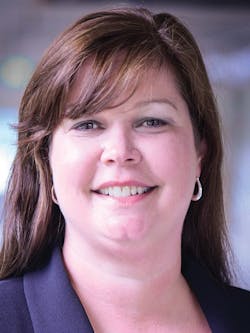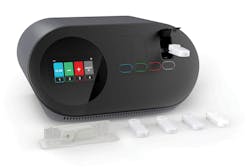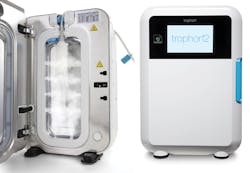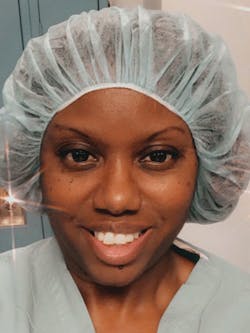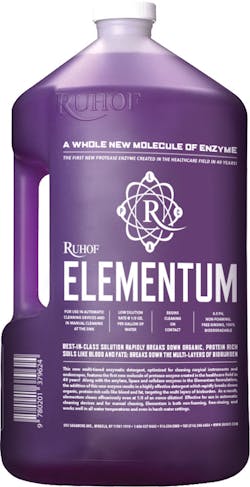Saying the first half of 2020 has been “disruptive” to the U.S. healthcare industry is a major understatement. With COVID-19 dominating care delivery, and healthcare facilities focused on both treating infected individuals and protecting those without the virus from contracting it (e.g. staff members, non-COVID-19 patients), most “business-as-usual” activities have been cancelled or delayed.
Elective procedures came to a grinding halt, in turn, stopping Central Sterile/Sterile Processing Departments (CS/SPD) in their tracks. Many health systems and hospitals have furloughed or laid off CS/SPD professionals because of slashed surgical procedure volumes – and associated revenue losses. Others have redirected department resources to other areas, such as the reprocessing of single-use personal protective equipment (PPE), including N95 respirator masks.
Now as the nation’s healthcare facilities begin to get back to business, CS/SPD professionals, like all other healthcare workers, are faced with uncertainty and fear. Concerns abound about elective procedures resuming – will they slowly ramp back up or will there be a surge in volume, coupled with a corresponding volume in instruments for reprocessing? Will CS/SPDs have the staffing levels required to meet increased demand for their services?
The COVID-19 pandemic has drained the nation’s PPE supplies; resulting in healthcare workers scrambling to secure masks, gowns and other products Cdesigned to protect them. As CS/SPD teams return to work, will they have the PPE they need to do their jobs? Will they be competing with other departments for these scarce resources?
In May 2020, the U.S. Food and Drug Administration (FDA) issued a letter to healthcare providers on the potential for CS/SPD staff members to misinterpret indicators used to validate sterilization because there is no standard color to indicate a sterilized device.1 The timing of this announcement has only added to concerns about CS/SPDs resuming work and the potential for heavier than normal case volumes that would overload their already strained resources.
As CS/SPDs plan for how they will operate under the “new normal,” they have the opportunity to reevaluate policies, processes and procedures for greater safety, quality and efficiency. In this article, we present insights from CS/SPD professionals, equipment and supply manufacturers, technology providers and others on best practices for resuming operations in a COVID-19 world.
More time for planning
Ideally CS/SPD leaders have taken the downtime caused by the COVID-19 outbreak to plan for their departments’ future states. As they ramp up staffing and operations, they should be communicating to their administration about the resources they will need to effectively and safely handle increased reprocessing volumes and new risks and challenges presented by the virus.
Determining staffing, equipment and other needs is a challenge because U.S. healthcare organizations are navigating unchartered waters. How do you prepare for a situation that you have never before experienced – recovery from an unprecedented modern-day pandemic?
“Despite the volume, CS/SPD teams are still responsible for safety; their own and that of their customers,” said Harris. “Anticipation of volumes and preparing as far ahead of the beginning of surgery volumes increasing is important. It is also important to seek out others who have already begun the process ahead of you; if possible. This way, there is an opportunity to decrease the need, or desire to want to reinvent the wheel and be able to learn from their mistakes. It is also helpful, if applicable, to duplicate successful processes used elsewhere.”
About staffing, Melinda Benedict, MS, CFER, Manager, Infection Control Program, Olympus Corporation of the Americas, says CS/SPD teams should anticipate increased volume once elective procedures resume and ensure they have adequate staffing levels to support the reprocessing of all instruments according to manufacturer instructions for use (IFU).
“It’s important not to rush or skip any steps, now more than ever,” said Benedict.
During this time, Coss encourages organizations to check trays for instrumentation in sets not being used and modify count sheet tracking systems with OR team coordinators, check sets for cracked or chipped instrumentation identification, identify improperly working instrumentation and send it out for repair, replace missing instrumentation and update set information.
Anna R. Gutierrez, AA, CRCST, CSPDT, CIS, CFER, Sterile Processing Program Director at Fortis College, points out how leaders must be aware of the details when preparing for an influx of surgical procedures. She encourages CS/SPD professionals to compile data to demonstrate their needs, including:
“Having good intentions will not be enough if patient safety is not at the forefront of our daily tasks,” said Gutierrez. “I highly encourage leaders to look into past records and analyze their numbers. As a leader, I know how many sets each team member can manage without setting them up for failure, and we can keep encouraging our teams to do more, but there is a logical limit to what your best technician can do.”
Greene-Golden says teams can leverage this resource to take down trays, check them for accuracy and missing instruments, and collaborate with their OR team to improve services, stating:
“The one department that did not have their processes impacted as to the daily workflow in hospitals was sterile processing. During this down time in surgical cases, sterile processing departments should have been proactive and done some much needed housekeeping. The ability of sterile processing to function safely will require that we follow standards and best practice to ensure our patients get clean, working and sterile instruments for their surgical cases.”
Workflow improvements
During these uncertain times, experts agree that CS/SPD leaders must ensure their teams are adhering to standard work, including industry standards (e.g. ANSI/AAMI). Standardized workflows and automation of manual tasks can help to boost efficiency, reduce errors and improve safety.
“When it comes to the reprocessing of surgical instruments and other medical devices during the COVID-19 pandemic, standardization—strict adherence to the current standard of care―is essential to protecting patients from risk,” said Douglas Mackay, VP of Sales & Marketing, Ruhof. “Today’s healthcare administrators are more focused than ever on the need to meet established standards, and more aware than ever of the consequences of not doing so. Media coverage and increased scrutiny by regulatory and accreditation agencies have elevated these issues.”
“Achieving best practices will require stakeholders across the full spectrum of involved disciplines to work together to establish standardized policies and procedures, as well as educational activities and competencies to ensure that those policies and procedures are effectively carried out,” Mackay added.
- Document the tasks being performed and how the task should be completed.
- Determine how the staff will have access to the standard work at the point of use so they don’t have to rely on memory. For example, place computer monitors above sinks displaying the decontamination standard work processes and other visual aids in the department to remind staff how to perform tasks.
- Implement regular follow-up by leadership to observe and ensure staff are following the standard work.
Sami El-Saden, CEO and Chairman of the Board, Verrix, says reducing variability and automating manual steps that lead to errors is one way to significantly improve workflow efficiency while boosting technicians’ confidence that trays of tools and devices have been properly sterilized.
“SPD technicians and managers have a difficult job, for which they don’t always get enough recognition, and their workload is only growing,” said El-Saden. “SPDs can’t afford rework or avoidable errors so investing in process improvement can pay dividends when it comes to meeting the increasing demands of clinical departments.”
El-Saden recommends that CS/SPD teams review quality metrics to understand if there are particular errors that are occurring repeatedly, and then implement a process change, a technology upgrade or additional training to address the issue. Verrix is currently developing a sterilization monitoring technology that is designed to eliminate common causes of errors while automating manual steps in order to provide improved efficiency and reliability.
“Verrix was founded to bring innovative, high-technology solutions to SPDs, to help ensure their tools meet the increased standards that other hospital departments have come to expect,” said El-Saden. “Every hospital department depends upon a well-functioning, effective SPD, and Verrix is committed to offering technicians better tools to get their important job done.”
Separating clean from dirty
Greene-Golden says one particular workflow area that is challenging to CS/SPDs is the separation of clean and contaminated items. To address this issue, she recommends that departments establish one-way flows for delivering and returning the case carts with either clean or contaminated items.
“The best practice and the guidance from ANSI/AAMI ST79:2017 teach that soiled materials must be isolated from the clean items to ensure acceptable processing conditions,” said Greene-Golden. “It is most important to facilitate the one-way flow even if it means putting up barriers or walls to help complete the segregation of soiled and clean items. Quality is automatically enhanced when the department can maintain the dirty from the clean.”
HLD and sterilization processes
As Ken Shaw, President of Americas, Nanosonics, explains, CS/SPD departments perform sterilization and high-level disinfection (HLD) on large volumes of reusable medical devices each day. Ultrasound is used in almost every healthcare department and being relied upon heavily in the management and monitoring of COVID-19 patients.
He notes how critical ultrasound probes (e.g. intraoperative probes, biopsy probes, or probes that contact sterile tissue) require sterilization, or HLD with use of a sterile sheath, if sterilization is not possible. Semi-critical probes (e.g. transvaginal probes, probes that scan non-intact skin) also require HLD with use of a sheath. Manual methods of HLD in the CS/SPD, such as soaking, are time consuming and prone human error. Therefore, the use of automated processes can not only boost workflow efficiency but also enhance quality and safety.
“Failures in meeting critical parameters during manual HLD (time, temperature and concentration) may compromise HLD efficacy,” said Shaw. “Manual methods could also expose staff handling chemistries to toxic chemicals, and insufficient manual rinsing may leave chemical residuals that could pose a risk to patients.”
“Fully automated ultrasound probe HLD with trophon2 or trophon EPR ensures the critical parameters are met every time, for every probe,” Shaw added. “The sealed hydrogen peroxide cartridge and overall closed disinfection design ensures there is minimal risk of chemical exposure. The hands-off cycle means staff can continue to perform other tasks maximizing overall efficiency and productivity in CS/SPD.”
Education and Training
Experts encourage leaders to re-educate and retrain CS/SPD teams on industry standards, manufacturer IFUs and their organizations’ specific protocols and pro- cesses as elective procedures resume. They should also provide education on new precautions or practices related to the handling of instruments used on COVID-19 infected patients.
“The one thing that I believe is paramount in CS/SPD improving their procedures to optimize safety is staying abreast of the education that is available,” said Harris. “In the times we are living, change is more rapid than it ever has been before. If we are not maintaining awareness through avenues of education, we are at a disadvantage. We may miss pertinent information that will be critical to the safety of the areas we serve.”
“Make sure staff and technicians are following the manufacturers IFUs, as well as taking into account any additional precautionary recommendations for instruments used on or around COVID-19 patients,” said Benedict. “Stay informed about new or modified recommendations from medical societies, the U.S. Food and Drug Administration (FDA), Centers for Disease Control and Prevention (CDC) and World Health Organization (WHO).”
According to Mackay, overcoming barriers to cleanliness requires vigilance, education and a team commitment to follow evidence-based practices, as well as manufacturers’ written IFUs. He states:
“Policies and procedures should include processes for containing contaminated instruments and minimizing airborne or contact spread of microorganisms. Key steps that should be standardized include pre-cleaning, transport, decontamination, and manual or mechanical cleaning. From cleaning chemistries and instrument and scope reprocessing products to cleaning verification and detergent delivery systems, Ruhof can serve as a valuable resource for your team.”
As a company that understands how ongoing education, training and mentoring are critical to the success of any clinical department, Ruhof offers a program of free accredited continuing education for nurses and CS/SPD techs at both local facilities and national association trade shows, including the 2020 Virtual Trade Show Events.
Monitoring and measurement
“An Annual Competency program that is directed by staff input and performed in situ by trained evaluators assures that all technicians are performing tasks according to department standard operating procedure (SOP),” said Czarnowski. “A good program prevents drift by experienced workers and demonstrates that new workers are trained to perform tasks in the same way. In situ teach back assessment also can discover environmental or mechanical factors that impact the work. Quality is the state of adherence to standards, not goodness.”
Coss acknowledges that all CS/SPDs have processes and procedures that when followed should ensure safety and quality. She says a simple technique to optimize and improve operations is to audit current processes and procedures using two simple steps:
“Ask yourself first if the team is following the procedures. Then as you audit job performance, ask yourself if there are changes that will improve the process. We also recommend periodic audits of final work products either after assembly or by randomly pulling trays to ensure they are 100 percent correct.”
Communication and collaboration
During times of “business as usual,” communication and collaboration between the CS/SPD and other departments, most notably the operating room (OR), is critical to success. The coordination of efforts is even more crucial as both sterile processing and clinical teams navigate these uncertain and changing times.
“First and foremost, ensure you have an open communication channel to the OR,” said Coss. “Perhaps in a business-as-usual climate, you can get away with a once daily meeting. But if case volumes surge as expected, you will need continuous flow communication with the OR.”
“Increased communication across the SPD, to the OR, to the surgery scheduling desk, to the surgeon needs to be utilized,” said Cox. “Importance needs to be placed on realistic expectations and possibilities. Delays need to be communicated quickly. The use of OR liaisons will help with flow, continue trust and increase reporting. An SPD navigator will increase throughput in the most productive way possible.”
Mackay urges CS/SPDs to extend process standardization beyond their four walls and into customer departments, noting how perioperative teams often struggle with pre-cleaning of today’s complex instruments and devices, especially given the variety.
Gutierrez recommends that healthcare facilities form small cross-functional teams comprised of both CS/SPD and clinical professionals, to organize how and when clinical devices will be reprocessed and handled. She states:
“Past experience has proved that small teams can better manage individual clinics, set up pick-up times and have better quality devices sent back into clinical rotation. These small teams are empowered to learn, lead and communicate any errors or deficiencies back to each department. As a result, most techs in the team find themselves delivering higher quality products because they have ownership of the process they helped create.”
Marcia Frieze, CEO, Case Medical, explains how the return to elective procedures provides a unique opportunity for cross-functional teams to assess their instrument set inventory. She recommends the following steps:
- For each set type, ensure there are enough instrument sets in inventory to accommodate planned procedures and allow adequate time for reprocessing.
- Look for opportunities to remove unnecessary instruments from the set, organize for ease of use and/or standardize contents across all sets of the same type. This will reduce the time needed for processing, improving department efficiency and set accuracy.
- Transition from wrapped sets to rigid containers. This will immediately reduce turnaround time by eliminating the wrapping step.
“If you decide to move to rigid containers, Case Medical’s SteriTite containers are manufactured with the highest quality materials and each container has a unique 2D bar code for paperless tracking,” Frieze added.
Additional considerations: PPE and BIs
Safety is always a priority of the CS/SPD, and it is always a challenge, but certain factors today are presenting even greater hurdles to protecting both patient and CS/SPD team-member safety. Two that have been in the media spotlight are the shortage of PPE supplies and the misinterpretation of indicators for sterilization. We asked our experts to provide their insights and advice on these two topics.
Addressing potential PPE shortages
“I have heard and read online that some sterile processing departments have run out of PPE and some are having a hard time acquiring the needed PPE to function daily,” said Greene-Golden. “If a sterile processing department runs out of PPE, they cannot work in the decontamination area and yes, this will impact their ability to function in patient care by not being able to perform their duties.
“This is unacceptable and against OSHA regulations for the protection of the healthcare worker,” she added. “Sterile processing team members must have PPE to clean and decontaminate instruments and equipment for patient care. So, no PPE means, in literal terms, no cleaning or decontaminating in the sterile processing department.”
“I think that CS/SPD leaders should be very vocal with their leaders and administration that proper PPE is essential to their process,” said Harris. “What may be a suitable solution in one area for preserving PPE, may not be a suitable solution in their areas. It is also important that leadership understand that there are certain requirements that are necessary for the PPE in CS/SPD departments to meet. Any old gown or glove won’t do.”
In recent months, PPE manufacturers have stepped up production of masks and other supplies in an attempt to meet the needs of healthcare workers. The U.S. government has also called on companies from outside of the healthcare industry to dedicate staff and manufacturing line resources to the production of PPE. Coss recommends that CS/SPD teams take advantage of industry resources aimed at combatting the COVID-19 pandemic.
“Lack of PPE has been all over the news for the past two months,” said Coss. “It is possible that some facilities may still face challenges in getting the supplies they need. Look for guidance from the manufacturers, FDA, CDC, and AAMI on methods to conserve and safely re-use PPE if possible.”
“The CDC has provided guidance on how healthcare providers can address PPE shortages,” said Benedict. “The CDC’s COVID-19 website is updated often, and so it’s important to check it regularly for updates. Even when there’s a shortage of PPE, facilities need to ensure employee safety.”
Gutierrez says her facility has experienced firsthand PPE shortages in the CS/SPD. She and her team have turned internally for support, leveraging their college/hospital affiliations to secure the required supplies.
“As our externship students return to hospitals, some departments have asked for extra PPE to support their needs,” said Gutierrez. “Within my organization, our leaders have considerately taken the time to supply us with PPE we can then share with our affiliated hospitals. Just another reason to support your local SPT training programs out there!”
According to Shaw, a transition from manual to automated processes in the CS/SPD can help ease the PPE shortage burden. He states:
“As many traditional soaking reprocessing methods require CS/SPD to suit up with full PPE to protect themselves from harsh chemicals, SPD departments may have to compete for available PPE within the hospital. If SPD doesn’t have the required PPE to reprocess reusable medical devices, this could potentially delay the reprocessing turnaround time. One way to work around this potential challenge is for hospitals to choose automated and enclosed reprocessing solutions that reduce the risk of exposure to chemicals.”
Biological indicator interpretation
According to Greene-Golden, indicator colors and the FDA’s announcement on the possibility of misinterpretation is a valid concern in the world of sterile processing. She states:
“Many years ago, you could not be color blind and work in the department because you needed to differentiate between colors. It is important that we be able to accurately determine if an item has met the parameters of sterilization by the color change of the indicator.”
Greene-Golden believes uniform color changes on all indicators would benefit CS/SPD professionals, making it easier to determine pass or fail of the strip. She said for now CS/SPD leaders must address the issue with education and constant checks to ensure their team members know which color means passed and which means failed.
Harris stresses that education and communication around the indicator challenges, within the CS/SPD and out to clinical teams, is essential to addressing the issue and easing concerns among personnel in both departments.
“Make a cheat-sheet with pictures and color change to help team members recognize the change of each indicator,” said Harris. “Even if the OR doesn’t ask, offer that very important information. ‘X, I don’t know if you’ve heard, but the FDA announced that it may be difficult to tell the difference between some of the indicators used in different sterilization methods. We have created a cheat-sheet to help us know the difference. I have e-mailed you a copy as well. Can you please share in your huddles?’ Being proactive can defuse the situation and the need to be reactive.”
Benedict recommends that healthcare organizations purchase only one brand of indicator to avoid confusion about the interpretation of color changes.
“Make sure staff have received training on how to interpret the color change for the brand of indicator you’re using,” said Benedict. “Consider posting signs near the sterilizers that visually show the color change as a reinforcement for staff.”
Gutierrez acknowledges that during the COVID-19 pandemic some healthcare organizations will continue to use chemical indicators from different manufacturers in different departments. She stresses the importance of CS/SPDs sharing IFU claims with those departments, performing in-services each time indicators from a different manufacturer are used, and conducting assessments when a change in indicators occurs to ensure staff members understand the colors and their meanings.
“The FDA’s announcement of the possibility to misinterpret indicator color at point of use brings spotlight to a challenge most CS technicians deal with every day,” said Gutierrez. “I have to agree that a standard color must be established with the FDA being the driving force behind it, not just for hydrogen peroxide but for all sterilization processes.”
Coss provides the following tips to help clear up confusion around indicator readings:
- Whatever product you choose, avoid making changes. Once people are programmed to a color code, it will be hard to move them to another.
- Ensure that the indicator’s instructions for use (IFU) are readily available.
- Educate CS/SPD staff on the appropriate processed and unprocessed indicators.
- Post a laminated picture of a processed indicator in the department areas so staff are able to see if the indicators have met parameters for sterilization.
Reference:
1. Risk of Misinterpreting Hydrogen Peroxide Indicator Colors for Vapor Sterilization: Letter to Health Care Providers, FDA, May 7, 2020 https://www.fda.gov/medical-devices/letters-health-care-providers/risk-misinterpreting-hydrogen-peroxide-indicator-colors-vapor-sterilization-letter-health-care
About the Author
Kara Nadeau
Senior Contributing Editor
Kara Nadeau is Sterile Processing Editor for Healthcare Purchasing News.



